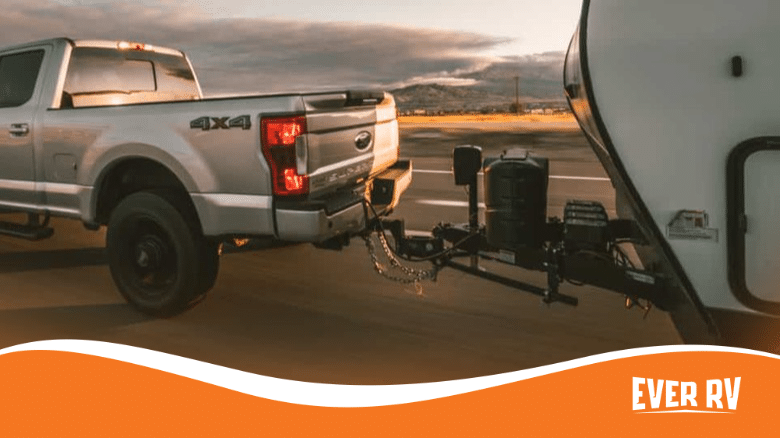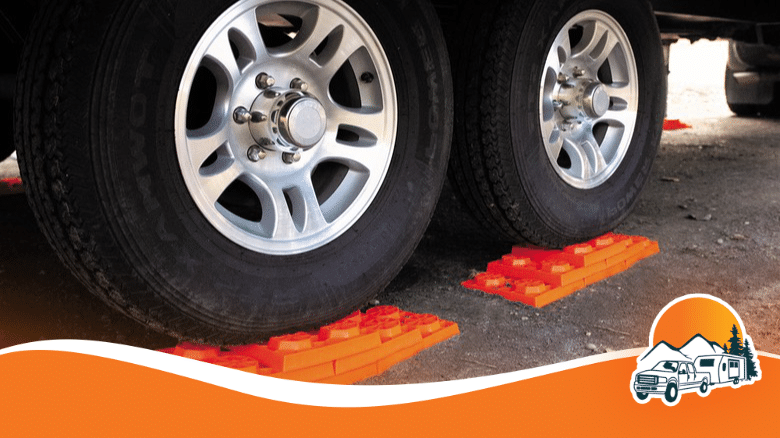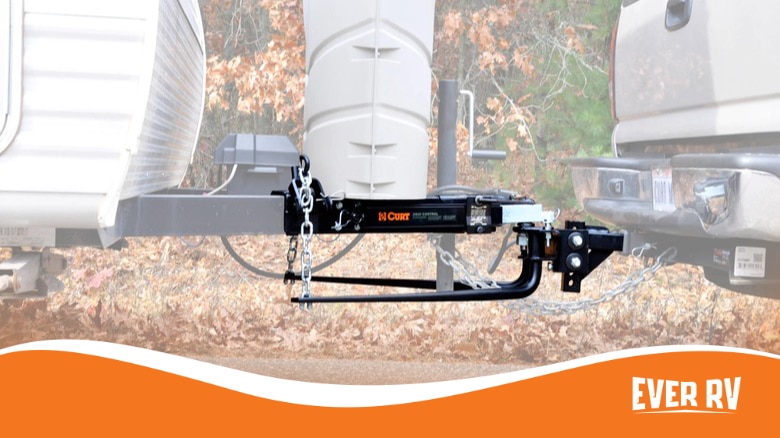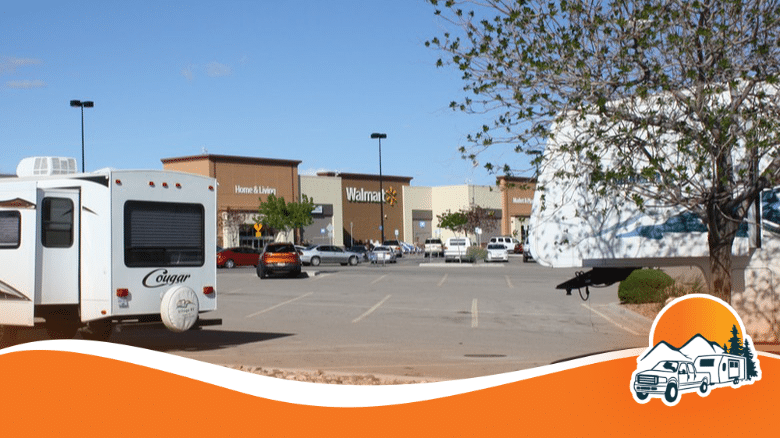How to select the right weight distribution hitch can be a real head-scratcher for many.
Ready to hit the road with your new trailer but need a weight distribution hitch?
The perfect weight distribution hitch. It’s not as simple as picking up any old piece of towing equipment.

Selecting the right weight distribution hitch is what separates a smooth, safe ride from an unstable, risky journey.
This task may seem daunting at first glance…
No worries! We’re here to help you navigate through this process with ease!
- Understanding Weight Distribution Hitches
- The Importance of Proper Weight Distribution
- Types of Weight Distribution Hitches
- The Role of Sway Control in Towing
- Selecting The Right Weight Distribution System For Your Vehicle
- Choosing The Right Hitch For Your Vehicle
- Installation And Safety Precautions
- FAQs in Relation to How to Select the Right Weight Distribution Hitch
Understanding Weight Distribution Hitches
A weight distribution hitch is an indispensable tool for any towing vehicle. It plays a pivotal role in maintaining stability and control during travel, ensuring safety on the road. The principle behind this system lies in distributing the load evenly across all axles of both your tow vehicle and trailer.
The components that constitute a typical weight distribution hitch include the receiver hitch, ball mount, trailer ball, trailer coupler, hitch pin, safety chains, and wiring harness. Each part serves its unique function within the entire assembly.
Hitch Ball And Trailer Coupler
The next component down the line is often referred to as either a ‘tow’ or ‘trailer’ ball – also known simply as Hitch Ball. This spherical device connects directly with another critical element: The Trailer Coupler – essentially forming what can be considered “the handshake” between your towed unit (like RVs) and their respective trailers.
The coupling process involves lowering it until securely fastened together by means of a locking mechanism provided at the base area where these two pieces meet each other head-on.
Safety Chains And Wiring Harness
To ensure utmost security while driving along highways/roads with heavy traffic conditions present everywhere, there are additional elements designed specifically towards enhancing overall roadside protection levels – namely Safety Chains & Trailer Wiring Harnesses, respectively.
Safety chains, typically connected from one side bracket located beneath the rear bumper region right underneath the tailgate section straight across the opposite end bracket situated similarly just below the front windshield edge region, act as fail-safe measures should primary connection points fail unexpectedly due to unforeseen circumstances arising out of nowhere suddenly without warning whatsoever beforehand.
In addition, the last but certainly not least important aspect concerning the complete setup comes in the form of electrical connections made possible through the use of specially engineered cable systems called “wiring harnesses.
The Importance of Proper Weight Distribution
When it comes to the world of towing, understanding weight distribution is more than just a good-to-know fact. It’s an essential part of ensuring your journey remains safe and efficient. But what does proper weight distribution mean? And why should you care?
In essence, this balance helps enhance steering control while reducing risks associated with undue stress on the rear axle caused by extra weight.
Gross Trailer Weight and Tongue Weight
If we delve deeper into these concepts, two terms come up frequently: Gross Trailer Weight (GTW) and tongue weight. For anyone planning a road trip or camping adventure using their RVs or trailers hitched onto vehicles, comprehending these terminologies becomes vital.
- Gross Trailer Weight: This represents how much your fully loaded trailer weighs at its heaviest – including cargo items such as bikes or kayaks, along with essentials like water tanks filled for use during travel.
- Tongue Weights: On the other hand, it denotes downward pressure exerted directly onto the hitch head attached to the towing vehicle from the total mass falling within the GTW category itself.
Selecting Matching Kits
Selecting kits that match GTW alongside appropriate tongue weights can be crucial in avoiding underperformance due to a lack of stability during transit, which may lead to damaged components such as spring bars. These are typically found in round bar kits used often within systems.
Types of Weight Distribution Hitches
A variety of weight distribution hitches are available on the market, each designed to cater to specific towing needs and road conditions. The three most prevalent types include Round Bar kits, Trunnion Bar kits, and Andersen Weight Distribution kits.
Round Bar Kits
The Round bar weight distribution hitch is a common choice for RV enthusiasts who primarily traverse paved roads devoid of dips or potholes. These systems employ round spring bars affixed to the trailer frame, which facilitate even dispersion of tongue weight across all axles – both your tow vehicle’s and your trailer’s.
This type typically handles a tongue weight range between 600-1200 lbs. It’s an excellent option if you own medium-sized trailers requiring smooth rides while retaining control over their rig.
Trunnion Bar Kits
If you’re looking at something more robust than round bar systems, consider Trunnion bar kits that offer higher ground clearance – beneficial when navigating gravel roads or uneven terrains. They also distribute the load evenly but can handle slightly larger capacities with tongue weights ranging from 600-1700 lbs.
This could be your best bet if adventurous trips involving rougher terrains or heavier loads are in the pipeline. Here is an insightful review of top-rated trunnion bar systems currently available in the market.
Andersen Weight Distribution Kit
Differentiating itself through its innovative design is Andersen’s Weight Distribution kit featuring chains instead of traditional spring bars along with shock absorbers ensuring smoother rides. Its friction sway control aids stability during windy situations, or high-speed overtakes by large vehicles.
This versatile system accommodates varying tongue weights ranging from 200-1400lbs, making it suitable for everything from small pop-ups right up to larger travel trailers. Check out this comprehensive guide detailing the specifications and benefits offered by these models.
The Role of Sway Control in Towing
Trailer sway can be a real menace on the road, causing your trailer to move side-to-side due to wind gusts or uneven roads. But there’s an effective way to combat this: sway control systems.
Sway control is crucial for towing as it applies frictional resistance at key points such as the hitch head and weight distribution bars. This limits lateral movement, ensuring that your trailer follows closely behind your tow vehicle rather than swaying unpredictably from side to side.
Built-In Sway Control Systems: A Closer Look
A built-in sway control system works by creating sufficient friction between the trailer frame and the ball mount. This reduces unnecessary movements caused by external forces resulting in a smoother ride with increased stability for both passengers and cargo alike.
An excellent example of these systems is found within Equalizer Hitches, which combine high-grade steel material with state-of-the-art fabrication processes leading to an exceptionally durable product capable of handling heavy loads without compromising performance levels.
The Importance Of Proper Setup And Maintenance
To get optimal results from any type of weight distribution system, including those with integrated sway controls like Equalizer Hitch, proper setup along with regular maintenance should never be overlooked.
If you’re unsure about anything during the installation process, consult professionals before proceeding further. An improperly installed or maintained hitch could negate all its potential benefits, potentially leading to dangerous driving conditions. Here’s a comprehensive guide.
Selecting The Right Weight Distribution System For Your Vehicle
Picking out the right weight distribution hitch size isn’t just about matching total weights but also considering factors such as the types of vehicles used and likely road conditions encountered throughout the journey duration.
Finding Budget-Friendly Options Without Compromising Safety Or Efficiency
If budget constraints are present, then options like EAZ LIFT offer effective performance at lower costs, making them ideal choices for many RV owners looking for safe, efficient travel experiences.
Tips To Ensure Maximum Safety During Travel With These Systems
Remember, always prioritize safety first when using these hitches. Always ensure they’ve been properly installed, preferably by authorized dealers, while taking necessary precautions during use will go a long way towards guaranteeing the maximum safety levels possible during travels.
Choosing The Right Hitch For Your Vehicle
The task of picking the right weight distribution hitch for your vehicle isn’t as daunting as it might seem. It’s all about understanding a few key factors: the total weight you’re planning to tow, what type of towing vehicle you have, and what kind of road conditions you’ll be dealing with.
Your first port-of-call should be checking out your towing capacity – this is essentially how much load your car can handle without compromising its performance or safety. This information will usually be in your owner’s manual or on the manufacturer’s website. Overloading beyond this limit could lead to serious driving hazards, so it’s critical not to overlook this step.
You also need to consider both gross trailer weight (GTW) which includes the combined weights of both the trailer and cargo, plus tongue weight – that downward force exerted by a loaded trailer onto a hitch ball – when determining suitable hitches.
Budget-Friendly Options
If budgetary constraints are part-and-parcel with selecting an ideal hitch system for yourself, don’t worry. Cost-effectiveness is guaranteed with various models offering safety and efficiency at a reasonable price.
A prime example would be EAZ LIFT Weight Distribution Hitches which boast quality features like sway control along with varying GTW capacities ranging from 600lbs up to 1400lbs depending on model selection. They’re convenient as well, coming with simple-to-follow installation guidelines, making them an ideal choice for those just starting out using these systems.
Remember, though, always prioritize compatibility over price when choosing between different types of hitches. Improper fitment could result in inadequate load balancing, leading to potentially dangerous situations during travel.
Also note: While self-installation might be tempting due to potential savings upfront, hiring a professional installer ensures correct setup, thereby maximizing the effectiveness of each component within the chosen system. It’s something worth investing in for peace of mind in the long run.
Installation And Safety Precautions
The process of installing a weight distribution hitch is not as simple as hooking up the components and hitting the road. It’s an intricate procedure that demands technical expertise, precision, and strict adherence to safety protocols.
This task isn’t something you should attempt on your own unless you have extensive experience with trailer hitches. Instead, it’s advisable to hire an authorized dealer for this job. These professionals possess the necessary skills to ensure everything is set up correctly for optimal performance.
An improperly installed weight distribution system can lead to numerous issues, including poor sway control, inadequate transfer of extra weight from the rear axle to the front axle of the towing vehicle, or even detachment during travel – all posing serious risks while on the move. Therefore, always opt for professional help when dealing with the installation of these systems.
Towing Vehicle Inspection
Prior to embarking on any journey involving RVs or trailers attached via such equipment, irrespective of their size, thorough checks of both the tow vehicle itself are must-do items on the list: Checking tire pressure (including spare); testing lights and brakes functionality, as well as looking over the general condition of the vehicles for signs of wear or damage that could affect the ability to transport loads, among others safely. Also, remember to consider the load balance within the trailer too, since unevenly distributed weight can cause instability while driving, leading to potentially dangerous situations like tipping over on sharp turns, etc. So, pay close attention to how objects inside the camper/vehicle being towed are arranged so they don’t shift around unexpectedly, causing an imbalance later down the line, especially at high speeds or when highway conditions may demand it from time to time.
Safety Measures During Travel
Moving forward after having done the required pre-trip inspections and preparations, continue staying vigilant throughout the duration of the trip – Always maintain a safe following distance behind other vehicles; keep an eye on weather forecasts along the route to avoid getting caught in bad storms; be aware of limitations imposed by the total combined weights involved: Towing capacity vs. Gross Trailer Weight plus Tongue Weight considerations, amongst others. Remember, safe travels start long before the engine starts running. Let’s enjoy open roads responsibly together.
FAQs in Relation to How to Select the Right Weight Distribution Hitch
Is it OK to oversize the weight distribution hitch?
Oversizing a weight distribution hitch can lead to reduced performance and potential safety issues. It’s crucial to match the hitch size with your towing needs.
Do I need a weight distribution hitch for a 3000 lb trailer?
If the tongue weight is over 10% of your trailer’s total weight, you should consider using a weight distribution hitch, even for trailers as light as 3000 lbs.
What is the easiest weight distribution hitch to use?
The Andersen Weight Distribution Hitch stands out for its ease of installation and adjustment, making it user-friendly, especially for beginners.
What is the proper height for a weight distribution hitch?
The correct height allows your tow vehicle and trailer to sit level when hooked up. This usually means adjusting so that the coupler sits about an inch higher than the receiver tube on your tow vehicle when unhitched.
In conclusion, understanding weight distribution hitches is the first step in safe and efficient towing.
Accurately calculating weight distribution is essential for ensuring vehicle performance and safety.
Choosing a hitch that matches your gross trailer weight and tongue weight ensures optimal functionality.
Whether you opt for Round Bar kits, Trunnion Bar kits or an Andersen Weight Distribution kit depends on factors like ground clearance requirements and expected road conditions.
Sway control plays a critical role in mitigating trailer instability during travel – don’t overlook this feature when selecting your hitch!
Budget constraints? There are cost-effective options out there that deliver without compromising on safety or efficiency. And remember: installation by an authorized dealer isn’t just recommended – it’s crucial for ensuring maximum safety during travel.
Selecting the right weight distribution hitch may seem complex, but with careful consideration of these key points, you’ll make an informed choice tailored to your needs.







